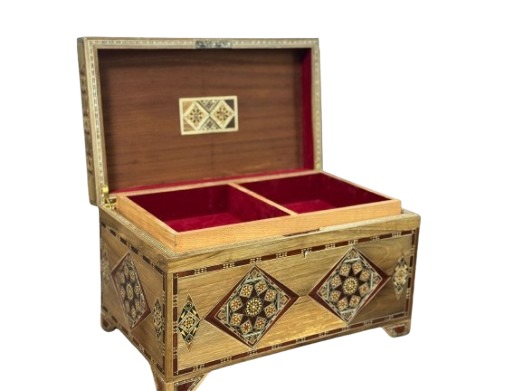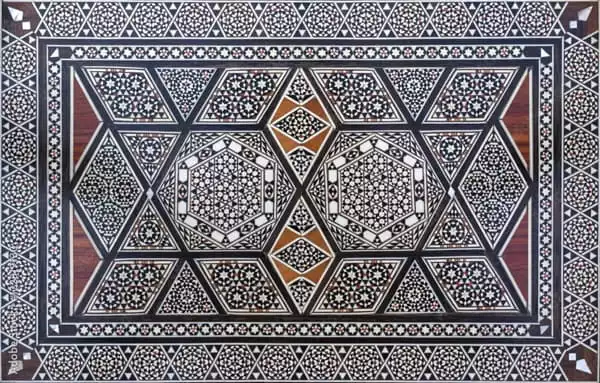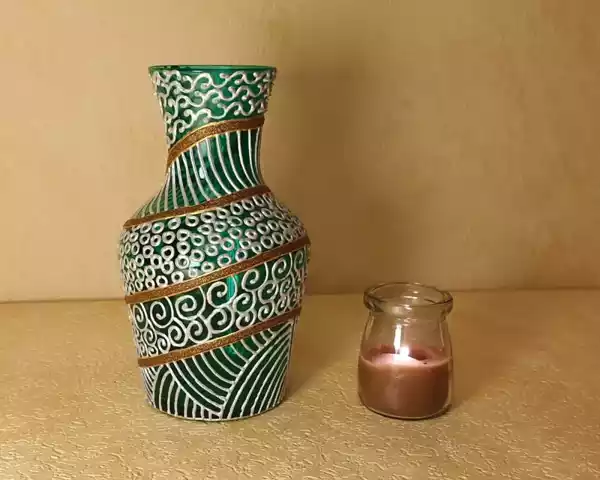Mosaic Box Geometric Perfection: Unveiling the Artistry
The Mosaic Box represents a specific, demanding form of artistry unique to Damascus craftsmanship.
It is not a mosaic made of stone or ceramic, but a meticulous marquetry of dyed woods, known locally as Fosayfasa’.
This technique transforms simple pieces of wood into complex, three-dimensional geometric surfaces.
The Mosaic Box is, therefore, a functional container that is also a breathtaking display of mathematical art and manual skill.

The Intricate Technique of Mosaic
The creation of a true Mosaic Box is a multi-stage process that requires immense precision.
It begins by cutting various hardwoods into thin, geometrically shaped rods or strips.
These strips are often dyed naturally to achieve contrasting colors like red, green, black, and white.
The artisan then glues these rods together into large, complex bundles that form the intended repeating pattern (stars, cubes, or interlocking shapes).
Once the large block is set, the artisan slices off thin veneers.
These veneers, now revealing the pre-set geometric pattern, are then carefully glued onto the surface of the Mosaic Box.
Visual Depth and Geometric Complexity
The defining aesthetic of the Mosaic Box is its mesmerizing sense of depth.
The use of contrasting wood colors tricks the eye, creating the illusion of three-dimensional cubes and tumbling blocks.
This geometric precision is highly valued in Islamic art, where complex, repeating patterns symbolize the infinite nature of creation.
Every surface of the Mosaic Box—the lid, the sides, and sometimes even the interior dividers—is a study in visual symmetry.
This commitment to intricate detail ensures that the box acts as a powerful decorative focal point in any setting.
The Mosaic Box as Functional Storage
Beyond its artistic merit, the Mosaic Box serves an important practical function.
The “Large Handmade Damascus” box is designed to hold significant collections of items.
Whether used to secure precious jewelry, important documents, or simply as a sophisticated display piece, it is built for substance.
The solid wood construction provides excellent protection against dust and minor environmental changes.
Its mosaic surface is durable and robust, designed to be admired and used regularly for generations.
The combination of high art and high utility makes it an indispensable item for a refined home.
Mosaic vs. Mother of Pearl Inlay
While the Damasch Magic East site features both styles, the pure Mosaic Box offers a distinct visual character.
Mother of Pearl inlay (Tarsh) relies on the luminescence and shimmer of shell against dark wood.
The Mosaic Box, conversely, relies on the rich, matte contrast of wood grain and color.
It celebrates the natural beauty and variety of hardwood textures.
Sometimes, the two techniques are combined, but the traditional geometric wood mosaic stands as an art form entirely in its own right.
It is a more restrained, visually textural approach to Damascene decoration.
The Investment in Mosaic Labor
The sheer labor required to prepare the mosaic materials contributes significantly to the box’s value.
The time spent cutting, dyeing, assembling, gluing, and curing the large geometric rods is immense.
This pre-assembly process is unique to the Mosaic Box and is what makes it so distinctive from other inlaid pieces.
This dedication to a slow, multi-stage handmade process ensures the box is a true luxury item.
It represents an investment in human expertise, not just in the materials used.
Conclusion
The Mosaic Box is a masterpiece of geometric marquetry, a true icon of Damascus craftsmanship.
It offers unique visual depth, structural integrity, and versatile functionality.
As a handmade treasure chest, it perfectly embodies the cultural sophistication and artistic heritage of the Levantine tradition.
Own a Mosaic Box and secure your treasures within a stunning, enduring work of art.
contact us via wahtsapp
Category: Mosaic Box



